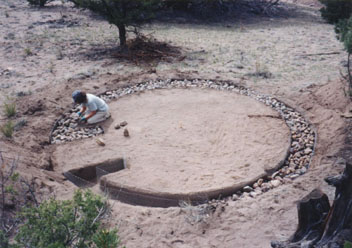Earthbag foundations offer many advantages over reinforced concrete foundations and work well with many types of sustainable buildings. In particular, they are low-cost, fast and easy to build, require no cement (a major expense and cause of global warming), and require no forms or expensive equipment.
Earthbags are simply polypropylene sandbags (rice or feed bags, for example) filled with soil, sand or aggregate obtained from or near the building site. Unlike adobe or rammed earth, which require a rather specific mix, almost any type of soil or aggregate will work (expansive clay soils are not recommended for foundations). Aggregates are preferred for foundations because they will readily drain away any moisture and prevent wicking into the wall system.
Designed to control flooding and resist explosives, earthbags are amazingly strong, durable and versatile as long as they are protected from direct sunlight. Keep earthbags tarped until they are plastered.

Some typical uses include:
1. Earthbags on a rubble trench foundation (to raise wall system above grade) – Example: an earthbag wall or straw bale wall stacked on top of aggregate-filled earthbags or earthbags filled with cement/lime stabilized fill material.
2. Aggregate-filled earthbags starting below grade and extending well above grade in flood-prone areas (reduces risk of the structure being undermined) – Example: a rubble trench could get scoured away and soil-filled bags on lower courses could dissolve in a flood.
3. Earthbags filled with scoria (lightweight volcanic aggregate) in cold climates – Example: scoria-filled bags are equivalent to a frost-protected foundation, and therefore eliminate the need for rigid foam insulation and extensive excavation.
4. Scoria-filled bags in desert regions or tropical climates as a cooling strategy
For more information: EarthbagBuilding.com

Are their any of these homes in Iowa ? if so is there a chance I could look at one ?
You might take a look at this post: https://naturalbuildingblog.siterubix.com/earthbag-hobbit-house-building/ where you might find more information about the owners.
I am building a small shed (11′ round) out of earthbags. Gravel (or any kind of stone) is cost prohibitive in this area. As well the the ground will freeze to 5 or 6′ deep here. Is it possible to fill a trench with sand (which I have here in abundance) with a sloping drain (also filled with sand)? Can I build with earthbags directly onto this? I can stabilize the first two courses with lime above ground level. Or should I fill earthbags with sand down to 5′ and backfill the soil around that?
Do any of these suggestions have merit?
Thanks,
Gerry
It is possible to build with earthbags on a sand foundation, as I have done this in Colorado where the frost depth was also about that deep. In this case the entire lot was nothing but sand. You can see a description of that project at http://earthbagbuilding.com/projects/hart.htm
If your native soil naturally drains well anyway then this could be a viable option for you. Providing a French drain at the base of the trench would assure that frost upheaval should not be an issue. I would not fill the French drain with sand as the water needs to be able to flow freely.
I would fill the first two courses with sand to inhibit moisture wicking into the rest of the wall. A stabilized plaster over this is a good idea.
Hi my name is Jeff and I live in the southern part of Iowa. The soil is mainly clay; would this type of soil be suitable for an earthbag home? Would like to build the solar pit home but don’t know how to get a full set of plans and step by step instructions. Can you help me out?
That’s one of free plans. Go to our free plans page, scroll down, and click the PDF to download.
My ebook shows every step of construction with photos and videos online. You can also order a DVD with for more video. https://naturalbuildingblog.siterubix.com/owens-book-dvd/
Can we use broken celcon / thermalite blocks in polypropylene bags for below ground foundation for a straw bale roundhouse?
Yes, as long as the material does not absorb water. Otherwise it can wick moisture up into the wall and/or freeze and expand and break apart.
I have been interested with earthbag bag and chose to do my final year project about investigation of earthbag foundation, but have difficulties as most of the sources says different materials, methods about the subject, can you use soil instead of sand and gravels in foundation as it is the cheapest material we have in Rwanda
If it rains a lot then the lower bags can turn to mud and cause the whole house to collapse. Use gravel or busted rubble from old buildings (no big sharp pieces).
The abiltiy to think like that shows you’re an expert